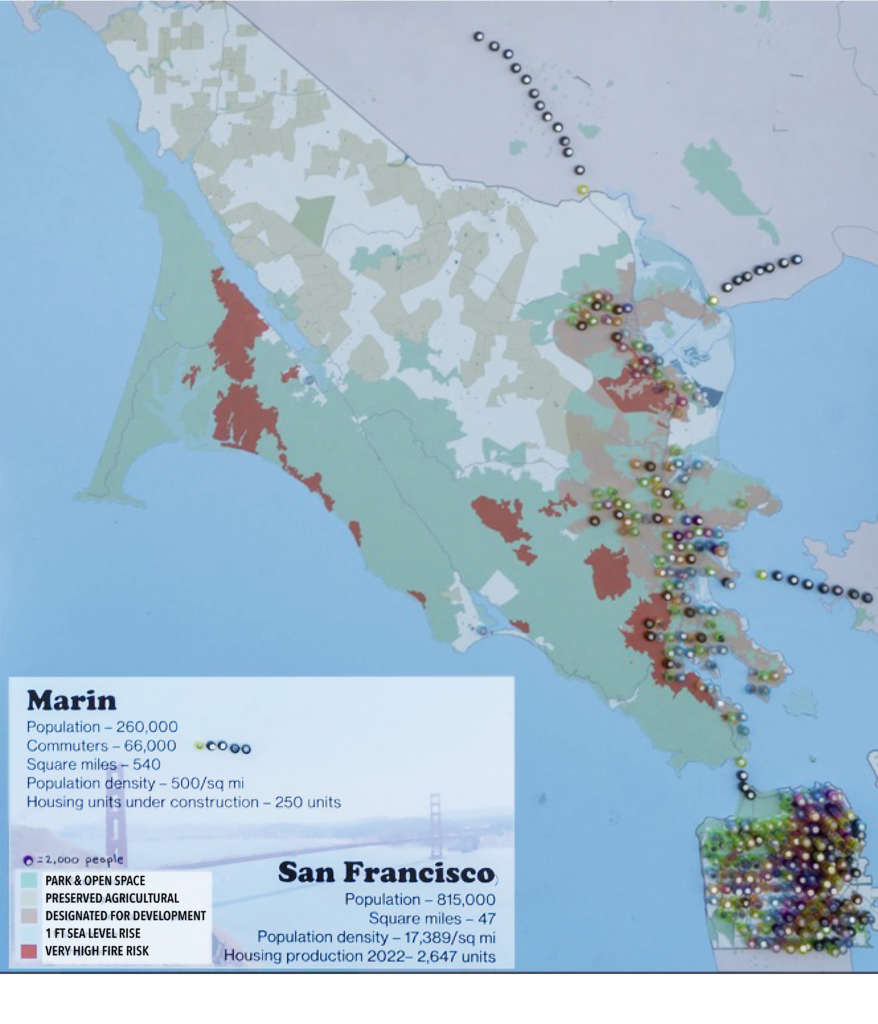Housing and Environment: It’s not either/or
Marin’s history of environmental protection is our defining pride. Yet our development practices are fundamentally anti-environmental.
Our history of environmental protection is Marin County’s defining pride. Outside narrow strips along Highways 1 and 101, rolling green hills rise and fall, mostly undisturbed by development, before meeting the brooding beauty of miles of untouched coastline. Compare this image with the concrete jungle of San Francisco, and it seemingly only serves to prove that Marin is a rare environmental steward in the modern age. Yet, as green as our landscape appears, this impression is false: our development practices are fundamentally anti-environmental.
While protecting our open spaces is the right choice, Marin’s lack of reasonable housing density along our suburban corridors is not; it results in excess greenhouse gases pouring into the atmosphere, and it pushes sprawl elsewhere. Currently, we actually produce 40% more emissions per capita annually than San Francisco. In fact, there is no debate among scientists: one of the most effective ways cities can combat climate change is by increasing urban density. Advocacy groups like the Sierra Club have followed this advice by strenuously arguing for urban infill as a “key environmental and climate strategy.”
And make no mistake, climate change is the environmental battle of our lifetimes. Millions of lives, countless coastal regions, and an inconceivable number of species and ecosystems are on the line. While we don’t need to replicate San Francisco, we cannot consider ourselves pro-environmental while doing nothing. As a place that will face rising sea levels and increasingly common wildfires head-on, the answer is clear: we must build more homes.
The climate impact of cars
The sparse development throughout Marin forces residents to rely on cars to travel long distances across the region. Compared to San Francisco, Marin emits almost three times as much greenhouse gas per capita from surface transit as San Francisco. This is particularly true of those commuting into the county. Because Marin so severely lacks affordable housing (the median cost of a home in Marin is $1.7 million, making us one of the most expensive counties in the country), over two-thirds of our workforce is forced to commute. That’s the highest proportion in the Bay Area and our number of “super-commuters” – those who drive over 1.5 hours for work – increased by 71% between 2009 and 2017.
By building more affordable housing in Marin, we would decrease the number of commuters and make our towns more walkable to residents. One study from the University of Illinois found that doubling density in the average city would decrease per capita carbon emissions from residents traveling by about 50%. As surface transit makes up over 50% of our greenhouse gas emissions, this is a big deal for our climate footprint.
The climate impact of energy-inefficient homes
The bulky, single-family homes that populate most neighborhoods throughout Marin are likewise fuel for climate change. While there are benefits to exceedingly large houses and immense separation between neighbors, energy efficiency is not one of them. Pumping heat and air-conditioning through every inch of these extensive structures consumes enormous amounts of energy. There’s also little to prevent that tempered air from quickly seeping through the walls and away from the house. On the other hand, compact urban homes require much less energy to heat and cool, as these buildings pair “fewer exposed walls and denser living areas” with wall-to-wall heat transfers with neighbors. As a result, even gentle increases in density would result in homes that produce a third of the greenhouse gases of our current suburban homes.

STARK CONTRAST: Each dot on the map represents 2000 people. While Marin’s land area is 540 square miles, our population is only 260,000. San Francisco is 47 square miles with a population of 815,000.
The climate impact of sprawl
Gentle density in Marin would change the climate impact of other cities as well. Because areas like Marin County have limited denser affordable housing for so long, we’ve simply forced many would-be residents to settle elsewhere. This trend has fueled the Bay Area’s appetite to devour countless miles of beautiful natural lands through residential sprawl. Since 1950, outer metro areas like Santa Cruz, Santa Rosa, and Napa have increased in physical size by over 300%, and even today, areas across the Bay see near-constant fights over whether to continue expanding.
We can’t force these areas to reduce sprawling development, but by constructing an adequate supply of affordable homes in Marin, we can reduce the demand for housing in these suburban fringes. And while many residents worry that we’re built-out in Marin, the truth is that we would not need to place a single new home in any of our open spaces. Back in the 1970s, we set aside small slices of land along our transit corridors for residential development to protect our wilderness. We just haven’t made good use of them yet.
So let’s change that. Let’s build affordable homes to protect the environment — as we’ve always intended.
| RESOURCES |
| TRANSFORM.ORG: Bay Area votes have a chance to approve a historic investment in affordable housing in November 2024. The regional housing bond measure will raise $20 million and build and preserve 72,000 units of affordable housing, many near transit. https://transformca.org/regional-housing-measure/ HOUSING FOR ALL MARIN: A coalition of Marin nonprofits educating the public about Regional Measure 4, the Affordable Housing Bond. https://housingforallmarin.org/resources/affordable-housing-is-the-easy-environmental-choice/ TERNER CENTER FOR HOUSING INNOVATION: Understanding the Role of New Housing in Reducing Climate Pollution https://ternercenter.berkeley.edu/research-and-policy/role-of-new-housing-in-reducing-climate-pollution/ SIERRA CLUB: Smart growth and urban infill. https://www.sierraclub.org/smart-growth-urban-infill MTC Vital Signs: https://vitalsigns.mtc.ca.gov/indicators/greenhouse-gas-emissions BROOKINGS INSTUTUTION: https://www.brookings.edu/articles/we-cant-beat-the-climate-crisis-without-rethinking-land-use/ SACRAMENTO BEE: https://www.sacbee.com/news/california/article288589346.html NORTH BAY BUSINESS JOURNAL: Super commuting. ENERGY EFFICIENCY APARTMENTS vs SINGLE FAMILY HOMES |
| SAVE THESE DATES |
| MEETINGS & EVENTS COMING UP MEHC and Housing for All Marin will be tabling at Farmers Markets throughout Marin all summer. Come look for us when you are picking up your fruit and veggies. We also want to highlight these events: Let’s Talk About Housing – MEHC Education Program at the League of Women Voters Member Meeting (public welcome) September 9, 2024, 11 am –1 pm 4340 Redwood Highway, Suite F-133, San Rafael, CA 94903 Join us for an interactive conversation on affordable housing in Marin and Prop 5 that will be on the November ballot. 2024 Marin Senior Fair Wednesday, September 18th, 9:00 – 3:00 PM – Marin Center Exhibit Hall, San Rafael, CA. Come Visit us at the Senior Fair. We will be exhibiting with fun activities and information on affordable housing in Marin. Hope for Housing in Marin City MEHC presents: Affordable housing discussion. Thursday, September 26, 6:30 PMSenior Center 640 Drake Ave Sausalito, CA 94965 |
 MEHC works for the Marin community Many Marin workers, employers, residents and nonprofits support MEHC’s work to advance environmentally appropriate, culturally sensitive, and socially equitable affordable housing. If that includes you, please consider a tax-deductible donation to MEHC to help us keep working. Your support matters, thank you. |
